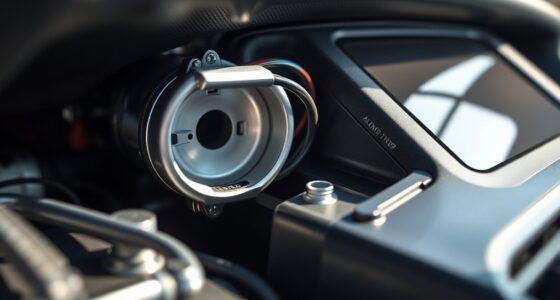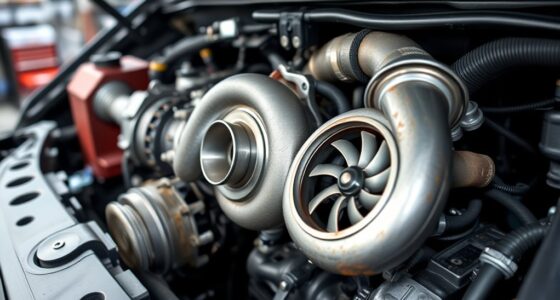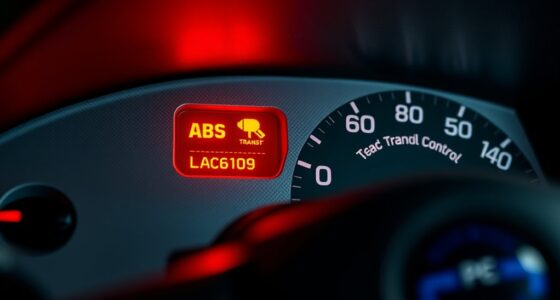If you experience vibration at 60–70 mph, start by checking your tires for uneven wear, damage, or imbalances, and make certain they’re properly inflated. Also, verify that your wheels are aligned correctly, as misalignment can cause wobbling. Worn suspension parts or faulty wheel bearings may also be at fault. Addressing these issues can improve your ride quality, and if vibrations persist, there’s more to uncover below.
Key Takeaways
- Check for unbalanced or damaged tires, uneven wear, and proper inflation to prevent vibrations at highway speeds.
- Ensure wheel alignment is correct to avoid pulling and wobbling during 60–70 mph driving.
- Inspect suspension components such as shocks, struts, and bushings for wear or damage affecting stability.
- Verify wheel bearings are in good condition, as looseness can cause vibrations at higher speeds.
- Perform professional balancing and alignment, and replace worn tires or suspension parts as needed.

If you notice your vehicle vibrating between 60 and 70 mph, it can make driving uncomfortable and even unsafe. That vibration isn’t something to ignore; it often signals underlying issues that need attention. When your car starts shaking at these speeds, it’s usually due to problems with the wheels, tires, or suspension components. Recognizing the cause early can prevent more serious damage and guarantee your safety on the road.
Vibrations between 60 and 70 mph may indicate tire, wheel, or suspension issues needing prompt attention.
One common cause of highway vibration is uneven or unbalanced tires. When your tires aren’t properly balanced, they can create a wobbling sensation as they rotate at higher speeds. This imbalance often results from hitting potholes, curbs, or general wear and tear over time. Checking your tire balance is straightforward: visit a mechanic or tire shop where they can quickly detect any imbalance using specialized equipment. If they find an issue, they’ll balance your tires, which typically restores smoothness and eliminates the vibration.
Another frequent culprit is tire wear or damage. Worn-out tires with uneven tread or bulges can cause vibrations that become noticeable at highway speeds. Inspect your tires for signs of uneven wear, cuts, or embedded objects. If you see irregularities, replacing the tires could resolve the issue.
Also, ensure your tires are inflated to the manufacturer’s recommended pressure, as under- or over-inflated tires can contribute to vibration problems and uneven wear.
Wheel alignment plays an essential role in maintaining smooth driving. Misaligned wheels can cause your vehicle to pull to one side and generate vibrations at higher speeds. If your steering feels off-center or pulls, it’s a clear sign you need an alignment check.
A professional alignment involves adjusting the angles of your wheels to meet the manufacturer’s specifications, which can improve handling, tire longevity, and eliminate vibration issues.
Suspension components are also worth inspecting. Worn or damaged shocks, struts, or bushings can lead to instability and vibrations. These parts absorb shocks from the road, and if they’re compromised, you’ll feel every bump and shake more intensely at highway speeds.
A suspension check by a qualified mechanic can identify worn parts that need replacing, restoring stability and reducing vibrations.
Finally, don’t forget to examine your drivetrain and wheel bearings. Loose or worn wheel bearings can cause wobbling, and issues in the drivetrain may also contribute to vibrations. If your vehicle makes noises or your steering feels loose, these are signs to have a professional inspect these components promptly.
Addressing highway vibration at 60–70 mph isn’t just about comfort; it’s about safety. Regular checks and maintenance of tires, wheels, suspension, and bearings will help you keep your vehicle running smoothly and avoid unexpected breakdowns or accidents.
To further prevent these issues, incorporating Mazda Tuning techniques, such as suspension tuning or wheel upgrades, can improve overall driving stability and comfort.
If you’re unsure about the cause, it’s best to consult a mechanic who can diagnose and fix the issue efficiently.
Frequently Asked Questions
Can Tire Balancing Alone Fix Highway Vibrations?
Tire balancing alone can fix highway vibrations if the issue is caused by uneven weight distribution in your wheels. When you get your tires balanced, it guarantees all weights are properly distributed, reducing vibrations.
However, if the vibration persists after balancing, you might have other problems like misaligned wheels, worn suspension parts, or damaged tires.
In that case, a thorough inspection is necessary to identify and fix the root cause.
How Does Uneven Tire Wear Affect Vibration Issues?
Uneven tire wear is like that one friend who never shows up on time; it throws everything off, including your ride. It causes imbalanced contact patches, leading to vibrations at highway speeds.
When your tires wear unevenly, your suspension and steering components work overtime trying to compensate. So, if you want a smooth highway cruise, fix that uneven wear—otherwise, you’re just asking for more vibrations and a less enjoyable drive.
Are Vibrations More Common in Certain Vehicle Types?
Yes, vibrations are more common in certain vehicle types, especially those with larger or heavier wheels like trucks and SUVs. These vehicles tend to experience more road impact and tire wear, which can cause vibrations at highway speeds.
Additionally, performance-oriented or older vehicles with worn suspension components may also be more prone to feeling vibrations. Regular maintenance and tire checks help prevent or reduce these issues.
Can Road Conditions Cause or Worsen Vibration Problems?
Road conditions are like a rough sea that can rock your vehicle’s stability, causing or worsening vibrations. Potholes, uneven pavement, gravel, and debris can throw your car off balance, making vibrations more noticeable at highway speeds.
When you drive over these irregularities, they jostle your tires and suspension, amplifying vibrations. Regularly checking your tires and steering components helps spot issues early, keeping your ride smooth even on the bumpiest roads.
How Often Should Wheel Alignment Be Checked?
You should have your wheel alignment checked at least once a year or every 12,000 to 15,000 miles, whichever comes first.
If you notice uneven tire wear, pulling to one side, or increased vibration, it’s a good idea to get it verified sooner.
Regular alignments help ensure smooth driving, improve fuel efficiency, and extend your tires’ lifespan, preventing vibrations and other handling issues.
Conclusion
If your car starts vibrating at 60–70 mph, don’t ignore it—problems rarely fix themselves. Check your tire balance, alignment, and suspension to catch any issues early. Sometimes, it’s just a small tweak away from smooth sailing. Remember, a stitch in time saves nine; addressing vibrations now can prevent bigger, more costly repairs later. Stay vigilant and keep your ride running smoothly so you can hit the road with confidence.









